Peter Samuel Cook was a serial rapist who attacked women in their homes in Cambridge, England, between October 1974 and April 1975. He was known in the press as the “Cambridge Rapist”.
Cook’s crimes were peculiarly theatrical. Today, we are still grappling with the idea that most rapes are committed by people the victim knew. Cook fit the stereotypical view of a rapist at the time, a socially marginal figure who broke into homes and assaulted strangers. Reportedly, if he didn’t find a victim, he would write taunting messages on their bathroom mirrors.
What’s significant for this discussion is that he wore a black leather hood with the word “RAPIST” literally written across the forehead. What puzzled me was, why and how did Cook get a leather mask? An ordinary cloth or wool ski mask or balaclava would have sufficed to conceal his identity.

In the 1960s, Nancy Grossman’s “leather head” sculptures had been exhibited, and there were adult digest magazines depicting full-head hoods in leather and rubber, but I don’t believe there were any mass-produced leather masks or hoods at the time. If they existed, they were expensive, custom-made pieces.
According to this unsourced claim:
The mask was reported to be “stitched from an old leather shopping bag. The zipper-mouthed mask had the word ‘rapist’ painted in white across the forehead”.
Another site says “He [Cook] made some efforts to protect himself, such as attaching false hair and a beard inside his mask….”
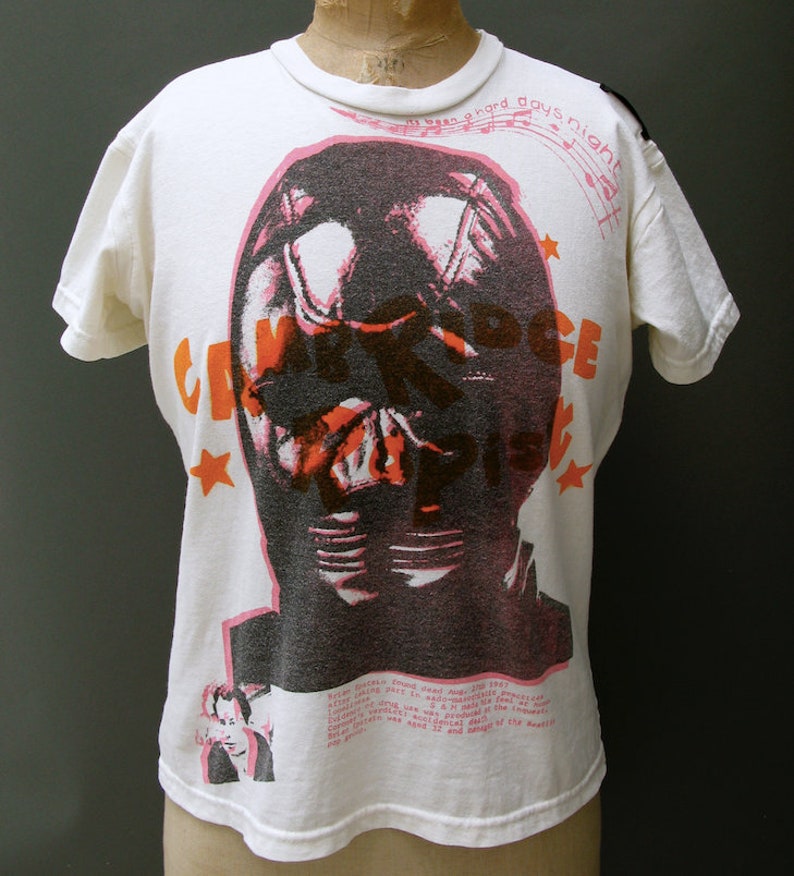
According to Simon Reynolds and Joy Press’ The Sex Revolts: Gender, Rebellion, and Rock’n’Roll (Harvard University Press, 1996, Pg.40-41), punk entrepreneur and provocateur Malcolm McLaren wanted to turn the Cambridge Rapist into a pop star. He designed (or had his partner Vivienne Westwood design) a shirt with the hood and “Cambridge Rapist” in pop star lettering, along with a smaller picture of “fifth Beatle” Brian Epstein and an allusion to him dying of S&M, not suicide. It was intended as a gift for “bored fifteen-year-old teenagers”, presumably the male kind. The photograph of the hood was by David Parkinson, according to Gorman.
In Fred Vermorel’s biography (Vivienne Westwood, Abrams, 1997), Westwood says an assistant at SEX feared that one of their customers was the rapist. Westwood decided to have the shirts and masks removed from the shop, only for McLaren to put it back, saying there was no such thing as bad publicity. (The assistant was Michael Collins, according to Paul Gorman.)
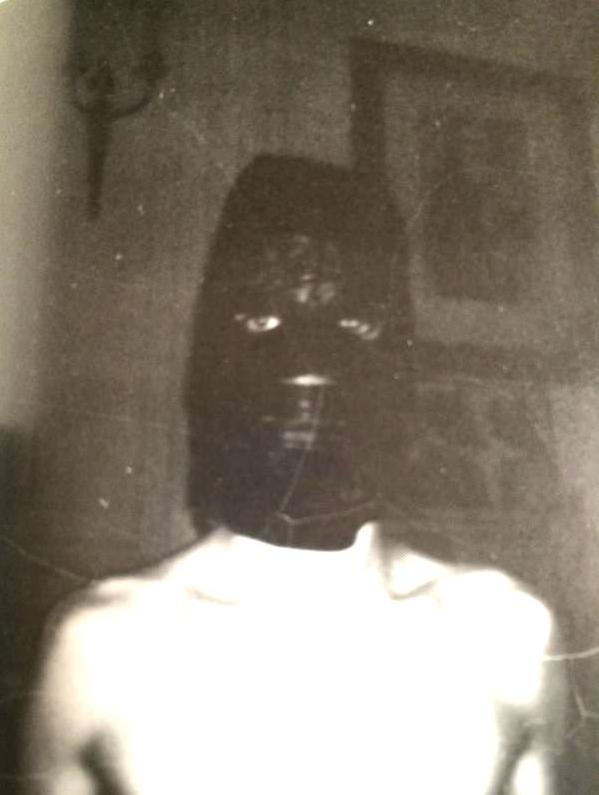
Paul Gorman’s blog features a scanned Polaroid of David Bowie in the summer of 1974, posing in a leather full-head hood. Bowie had visited the store that would eventually become Malcom McLaren and Vivienne Westwood’s SEX shop at 430 King’s Road in ‘74, searching for a new look for the Diamond Dogs tour in America.
…Bowie posed in a leather hood of similar style to the model sold at 430 as it was transformed over a period of six months from TFTL to fetish emporium Sex.
At the beginning of 1974 a couple of friends of McLaren’s had brought a number of hoods back to London at his request from an NYC trip of their own.
“Malcolm knew exactly where they were sold and told us to get a bunch, “says one. “We were pretty anxious bringing them back through customs but he was delighted to have them and put them on sale in the shop.”
This occurred at the time when Bowie was a 430 visitor (McLaren recounted how the superstar once requested a t-shirt bearing the image of James Dean in his “crucifixion” pose with a rifle across his shoulders in the movie Giant).
[…]
The hoods sold moderately well in Sex and fresh stock was made by McLaren and his partner Vivienne Westwood’s preferred specialist leatherwear manufacturer, Battersea’s The London Leatherman.
Note, however, that Gorman’s post mentions “the UK’s notorious “Cambridge Rapist” Peter Cook, who fashioned similar headgear to disguise his identity” (emphasis added) i.e. that Cook didn’t buy the hood, but made it himself. (That also raises the question of where McLaren’s friends got the hoods in NYC.)
Gorman includes a caveat:
It is not confirmed whether the hood featured in the Gillespie Polaroid of Bowie is from 430 King’s Road. “It could be that the mask was bought in New York from the same place Malcolm sourced his,” says McCann, “though – if it was indeed David’s mask – he may have bought it when he visited the shop.”
In November 1975, soft-porn mag Gallery International published a piece by underground journalist David May on SEX, which quoted McLaren:
During the interview May challenged McLaren (“Oh come on…”) on his insouciance regarding the victims of the Cambridge Rapist, the mid-70s leather-hooded and violent sex attacker Peter Cook who was the subject of a controversial t-shirt sold in the shop. McLaren’s answer revealed the underlying strength of his critique of British social and sexual repression as embodied not just by SEX, but also the Sex Pistols:
“Look, why treat him as an individual?” urged McLaren. “Why not treat him as a symbol of what is happening to everybody…I’m saying that if everyone did wear these clothes then this particular island, and all the violence that has been pushed down, would fucking explode!
McLaren himself said in a 2008 statement:
The CAMBRIDGE RAPIST t-shirt was designed by me upon my return from managing the New York Dolls. It was about a particular incident that occurred in the shop and worried those when they were accused of selling a leather mask to a supposed rapist who was terrorizing the town of Cambridge. I made that upon the week of my return from NY.
The shirt design is even part of the MOMA collection, attributed to Westwood, not McLaren.
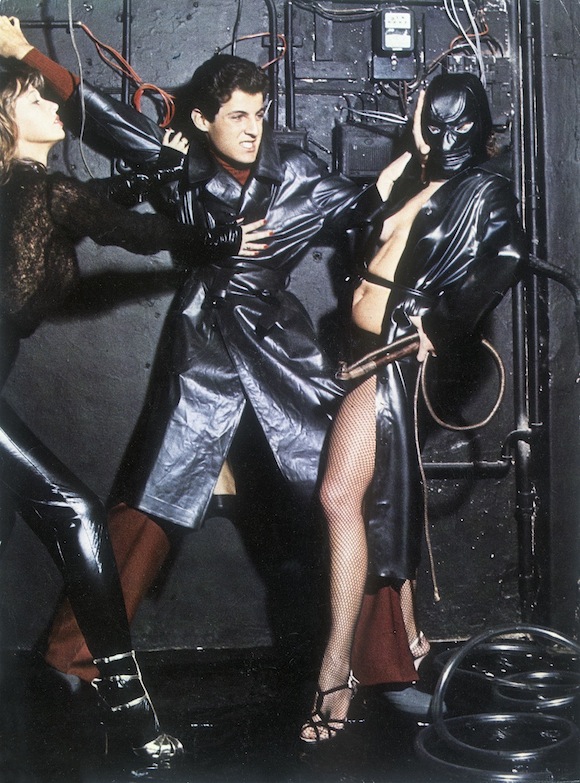
That lead to the question of where McLaren got his leatherwear. Another Man magazine interviewed fashion entrepreneur David Carroll, who says it all came from the London Leatherman, known simply as “Ken”. The article claims that “He supplied Malcolm McLaren and Vivienne Westwood’s Chelsea Sex boutique with their leathers, and even created the fated zip-mouthed mask worn by the Cambridge Rapist throughout his two-year manhunt.” (This contradicts the sources which say that Cook made the hood himself.) Carroll describes how, when he was in his early teens, his mother worked for Ken. The shop supplied two different subcultures with leather goods: San Francisco gay leathermen, and London punks, via McLaren & Westwood.
Like it or not, McLaren succeeded in making Cook, or rather “the Cambridge Rapist”, famous as a villain.
Black had been associated with violence for centuries, and by at least the 1920s, it was also strongly associated with criminality and deviant sexuality. In If Looks Could Kill (Marketa Uhlirova, ed. Koenig Books, 2008), Tom Gunning’s essay “Making Fashion out of Nothing: The Invisible Criminal” says that in French silent film serials of the 1910s, form-fitting black was the preferred wear of master criminals and anti-heroes. This can be traced back to the master villain Fantômas, created in 1911 by Marcel Allain and Pierre Souvestre in a series of French pulp novels. Fantômas’ foremost talent was disguise, and as he was never given a definitive origin, form-fitting black clothing and mask was his “look”, suggesting the lack of any fixed identity.
Leather masks and hoods, similar to Cook’s home-made version or the London Leatherman t-shirt version, turn up on other cinematic villains.
In Tightrope (1984), the antagonist, a serial rapist and killer, wears a black leather mask. As there’s never a clear shot of his face, this is the viewer’s only image of him.
The 1985 thriller Blackout also features a rapist/killer in a leather jacket and mask, though there is no explanation of where or how he got it. The mask only appears briefly in the film, but is prominent in the advertising. Fittingly, much of the film’s suspense comes from ambiguous identity. The plot concerns a family man who may or may not be a rapist and killer after losing his memory in a car accident.
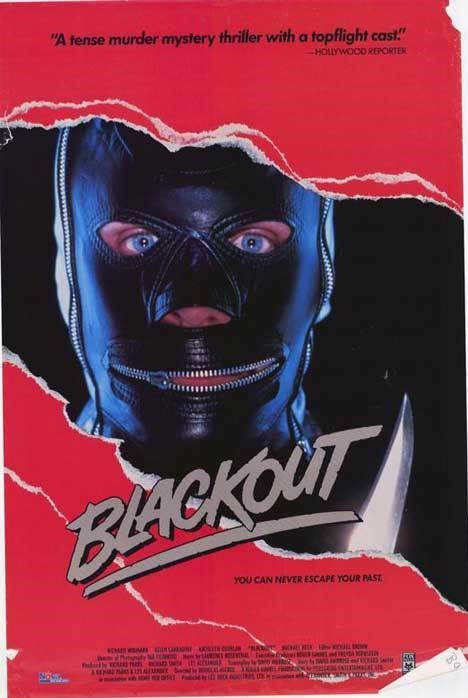
In Wes Craven’s The People Under The Stairs (1991), the character of “Father” or “Daddy” wears a full body leather suit and mask, to match the bondage gear scattered around the house of horrors.

Black leather is also the signature look of the killer in Zipperface (1992), a low-budget erotic slasher film. Zipperface was, in turn, paid homage in the video for the title track of Carpenter Brut’s album Leather Teeth (2018).
In 8MM (1999), one of the killers, a large man only known as “Machine”, is mainly seen wearing black leather clothing and a mask. It is only in the final confrontation that he takes the mask off, revealing the face of an ordinary-looking man.
In the first season of American Horror Story, an unknown figure wearing a full-body black rubber suit and hood, known as “Rubber Man”, commits a number of killings and rapes. It turns out that the Rubber Man suit was worn by multiple people, further obscuring individual identity.
It is tempting to claim that the Cambridge Rapist was an inspiration for the killers in Tightrope and 8MM. But I don’t know of any direct connection.
(Cook died in prison of natural causes in 2004.)

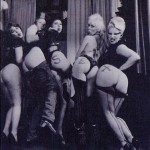


[…] also the strange case of the mask of the Cambridge Rapist, likely an indirect inspiration for this […]
Great article. The Sunday Mirror press clipping from 1975 here should clear up some of the questions brought up in your piece. Best. https://thelondonleatherman.com/talking-about-the-kit/2021/4/8/the-legend-of-the-london-leatherman-head-mask-lw11